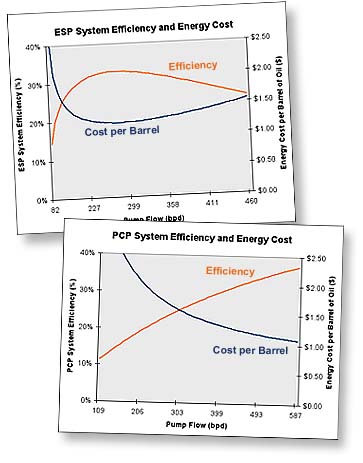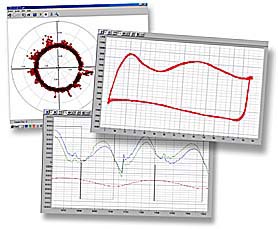
TECHNICALLY SPEAKING:
 A Comparison of the Energy Efficiency of Various Types
A Comparison of the Energy Efficiency of Various Types
of Artificial Lift Systems
by Rick Tennessen division manager
In the past, little emphasis was given to the relative energy efficiency of the various forms of artificial lift since each served separate pumping requirements. The introduction of large progressing cavity pumps (PCPs) has enabled the use of PCPs as alternatives to electric submersible pumps (ESPs) in many instances. Improved control methods have allowed rod pumps to compete with ESPs and PCPs in a number of applications. The overlap of potential artificial lift methods is also high in coal-bed methane production, where several different types of pumping systems are commonly used for dewatering coal seams.
The following comparison between beam, Rotaflex, progressing cavity, and electric submersible pumps is intended to give a qualitative sense of the relative energy efficiency of those pumping systems. Of necessity, the analysis was based on a 5,000-foot-deep well that might be a typical candidate for all four types of lift. A typical utility rate of $0.06 per kWh and 90% water cut were assumed to help emphasize the economic impact that the selection of an artificial lift system makes on an operator's utility bill. The results are shown in the table.
|
Artificial Lift Comparison Summary |
||||||
| Pumping System |
Pumping Speed (spm, rpm) |
Production Rate (bpd) |
Input Power (kW) |
Lift Power (kW) |
Energy Efficiency (%) |
Cost per Barrel ($) |
| Sucker Rod | 3.0 | 108 | 10.1 | 2.97 | 29.4 | 1.34 |
| 6.0 | 227 | 13.3 | 6.23 | 46.8 | 0.85 | |
| 9.0 | 362 | 20.8 | 9.94 | 47.9 | 0.88 | |
| 12 | 500 | 31.4 | 13.7 | 43.8 | 0.90 | |
| 15 | 637 | 47.1 | 17.5 | 37.1 | 1.07 | |
| Rotaflex | 1.0 | 110 | 4.33 | 3.02 | 69.8 | 0.57 |
| 2.0 | 222 | 8.75 | 6.10 | 69.7 | 0.57 | |
| 3.0 | 338 | 14.3 | 9.28 | 65.0 | 0.61 | |
| 4.0 | 461 | 20.3 | 12.7 | 62.4 | 0.63 | |
| 5.0 | 586 | 26.9 | 16.1 | 59.8 | 0.66 | |
| Electric | 2,355 | 82 | 15.5 | 2.24 | 14.5 | 2.73 |
| Submersible | 2,643 | 227 | 19.8 | 6.27 | 31.5 | 1.26 |
| 2,930 | 299 | 25.2 | 8.21 | 32.5 | 1.22 | |
| 3,216 | 358 | 31.9 | 9.85 | 30.8 | 1.28 | |
| 3,500 | 411 | 39.9 | 11.3 | 28.3 | 1.40 | |
| 3,783 | 460 | 49.4 | 12.7 | 25.6 | 1.55 | |
| Progressing | 175 | 109 | 26.1 | 2.98 | 11.4 | 3.42 |
| Cavity | 200 | 206 | 29.5 | 5.62 | 19.1 | 2.06 |
| 225 | 303 | 33.0 | 8.30 | 25.1 | 1.57 | |
| 250 | 399 | 36.6 | 11.0 | 30.0 | 1.32 | |
| 275 | 493 | 40.3 | 13.7 | 33.9 | 1.17 | |
| 300 | 587 | 44.0 | 16.4 | 37.2 | 1.08 | |
 |
|
System efficiency and energy costs versus flow for PCP and ESP systems. |
There are a number of general conclusions that one might draw from this comparison. Rotaflex units have the greatest energy efficiency due to their long-stroking design. Energy savings for those units, however, may be cancelled by high capital costs relative to other systems. By comparison, ESP energy efficiency is relatively low and falls off dramatically outside of its intended operating range. Sucker rod pumps also lose efficiency at high and low stroking rates, but not as dramatically as ESPs. PCP efficiency tends to increase in proportion to pumping speed. All pumping systems lose efficiency at low volumes due to leakage effects.
Unico has developed tools for assessing energy issues with artificial lifts that can help you make better decisions regarding the life-cycle costs of an installation. If you would like a detailed analysis, please contact us.
PRODUCT WATCH:
DriveLink™ Graphical Enhancements Help Users Visualize Well Performance
 DriveLink™, Unico's drive-monitoring software for personal computers, has recently been enhanced to provide graphical displays of well performance. The software, which allows a user to setup and monitor up to 99 drives from a Windows-based PC, is typically used to capture well production information, reset control functions, archive setup data, and display operating parameters.
DriveLink™, Unico's drive-monitoring software for personal computers, has recently been enhanced to provide graphical displays of well performance. The software, which allows a user to setup and monitor up to 99 drives from a Windows-based PC, is typically used to capture well production information, reset control functions, archive setup data, and display operating parameters.
Newly added enhancements include a chart-recorder-type plot that can be used to display rod-pump gearbox torque as a function of time, a circle chart commonly used for displaying motor torque in ESP applications, and an X-Y mode that can display rod-pump load and position in the familiar dynagraph format for analysis.
Contact us to learn more about DriveLink™.
FEATURE FOCUS:
Software Upgrade Benefits Existing Pump-Jack Drives
 A software upgrade has been developed for existing pump-jack controls that provides many of the advantages of our latest pump-jack drive systems with the simple change of a chip.
A software upgrade has been developed for existing pump-jack controls that provides many of the advantages of our latest pump-jack drive systems with the simple change of a chip.
Over the years, thousands of Unico variable-speed drives have been installed on pump jacks, many under the tradename Northlander™. The earliest units were limited to single-speed operation. Dual-speed control was added a number of years ago to improve well production using independent upstroke and downstroke speed settings. Both types of control required the operator to manually select the appropriate speed to maximize production while avoiding fluid pound and bridle separation problems.
Our latest generation pump-jack systems automate this process by selecting the ideal pumping speed based upon pump fillage. The new control, which incorporates many other improvements as well, requires use of the latest 40 MHz control module. However, a software upgrade is now available that provides older pump-jack systems with many of the enhancements of the new platform with a simple firmware change. Contact us for information on obtaining the upgrade if the features below would benefit your operation.
| Class I Beam Pump Drive Upgrade Features | |
|
·
|
Designed specifically for Class I beam pumps |
|
·
|
Operates without load cells and position sensors |
|
·
|
Assists in counter-balance selection |
|
·
|
Continuously computes pump fill |
|
·
|
Provides manual single- and dual-speed operation |
|
·
|
Automatically optimizes speed using pump fill |
|
·
|
Allows variable-speed or start/stop pump-off control |
|
·
|
Provides continuous readout of crank angle |
|
·
|
Prevents damaging downstroke bridle separation |
|
·
|
Saves energy by optimizing pump fill |
|
·
|
Constant-power control allows increased sheave ratios |
|
·
|
Provides a serial communication channel for remote data access |
|
·
|
Includes both RTU and ANSI II communication protocols |
WHAT'S COMING UP:
In Future Issues...
Look for the following articles in upcoming issues of Oil & Gas Automation Solutions:
| Integral dynamic braking option included in new 1105 series drives | |
| Using harmonic filters to satisfy utility power quality regulations | |
| Software option allows use of Palm Pilots for monitoring and archiving well parameters | |
| 1110 series drives allow operation of artificial lift pumps from single-phase power sources | |
| Rotaflex maximum pumping capacity increased 33% using novel speed control |
Oil & Gas Automation Solutions is a publication of Unico, Inc. Copyright © 2002 Unico, Inc. All rights reserved.
All trade designations are provided without reference to the rights of their respective owners.
![]() Unico, Inc., 3725 Nicholson Rd., P. O. Box 0505, Franksville, WI 53126-0505
Unico, Inc., 3725 Nicholson Rd., P. O. Box 0505, Franksville, WI 53126-0505
262.886.5678 / 262.504.7396 fax
oilgas@unicous.com / unicous.com